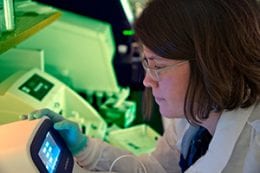 Your fingerprint on your hands is unique to you. So is your DNA sequence. Organisms such as bacteria, viruses and humans are made up of DNA, a composition of bases A, T, C, and G, that give a unique pattern. How those bases are ordered is called sequencing. Therefore, whole genome sequencing identifies the complete order of bases in the genome. For food safety, whole genome sequencing is being used to identify bacterial contamination and how they are linked to a foodborne illness outbreak.
Your fingerprint on your hands is unique to you. So is your DNA sequence. Organisms such as bacteria, viruses and humans are made up of DNA, a composition of bases A, T, C, and G, that give a unique pattern. How those bases are ordered is called sequencing. Therefore, whole genome sequencing identifies the complete order of bases in the genome. For food safety, whole genome sequencing is being used to identify bacterial contamination and how they are linked to a foodborne illness outbreak.
Whole genome sequencing is now available in all 50 states, with the help of the Centers for Disease Control and Prevention, to help health departments expedite foodborne illness outbreaks like never before. It is like comparing all of the words in a book to another book, not just the number of chapters. It is fast, affordable, and can be done in one test.
While whole genome sequencing will not prevent outbreaks, it has greatly improved the speed of investigation and tracking of bacteria related to foodborne illness.
www.cdc.gov/pulsenet/pathogens/wgs.html